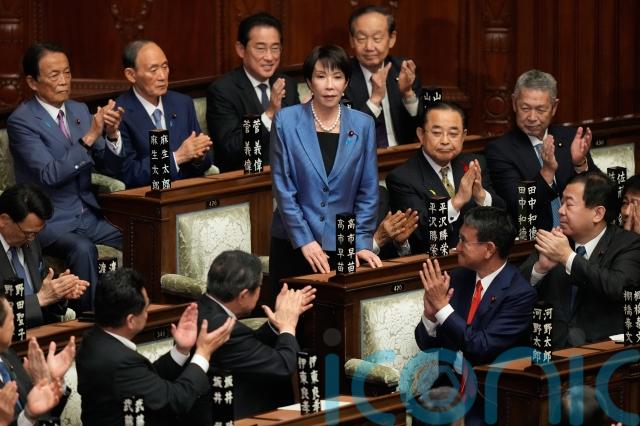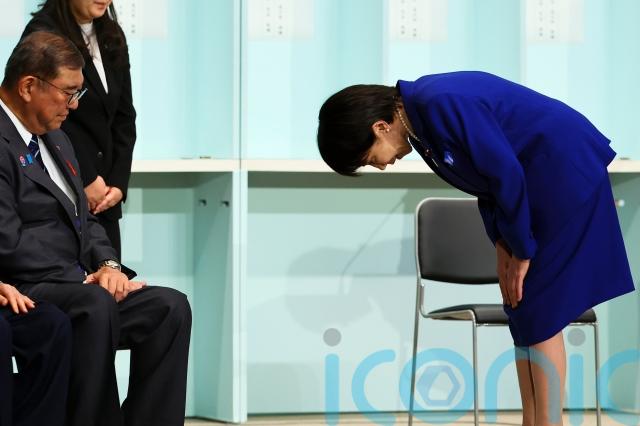
Japan’s parliament has elected ultra-conservative Sanae Takaichi as the country’s first female prime minister, a day after her struggling party struck a coalition deal with a new partner expected to pull her governing bloc further to the right.
Ms Takaichi replaces Shigeru Ishiba, ending a three-month political vacuum and wrangling since the Liberal Democratic Party’s disastrous election loss in July.
Mr Ishiba, who lasted only one year as prime minister, resigned with his Cabinet earlier in the day, paving the way for his successor.
Ms Takaichi won 237 votes — four more than a majority — compared to 149 won by Yoshikoko Noda, head of the largest opposition party, the Constitutional Democratic Party of Japan, in the lower house. As the results were announced, Ms Takaichi stood up and bowed deeply.

Ms Takaichi, 64, appointed former defence minister Minoru Kihara as chief cabinet secretary. She also appointed her leadership rivals within the party to her government along with other veteran politicians.
Toshimitsu Motegi, who previously served as both trade and foreign ministers, was named foreign minister, while former agriculture minister Shinjiro Koizumi was named defence minister.
Former chief cabinet secretary Yoshimasa Hayashi was named internal affairs and communication minister. Ms Takaichi also appointed Mr Ishiba’s chief trade negotiator, Ryosei Akazawa, as economy and trade minister.
Despite her earlier pledge to drastically increase the number of women in the cabinet, she appointed only three, all of them supporters in the party leadership vote — former regional revitalisation minister Satsuki Katayama as finance minister, Kimi Onoda as economic security minister and Midori Matsushima as the prime minister’s aide.
The LDP’s alliance with the Osaka-based right-wing Japan Innovation Party, or Ishin no Kai, ensured her premiership because the opposition is not united.
Ms Takaichi’s untested alliance is still short of a majority in both houses of parliament and will need to court other opposition groups to pass any legislation — a risk that could make her government unstable and short-lived.
“Political stability is essential right now,” Ms Takaichi said at Monday’s signing ceremony with the JIP leader and Osaka governor Hirofumi Yoshimura. “Without stability, we cannot push measures for a strong economy or diplomacy.”
The two parties signed a coalition agreement on policies underscoring Ms Takaichi’s hawkish and nationalistic views.
Their last-minute deal came after the Liberal Democrats lost its long-time partner, the Buddhist-backed Komeito, which has a more dovish and centrist stance. The break-up threatened a change of power for the LDP, which has governed Japan almost uninterrupted for decades.

Tackling rising prices and other economic measures is the top priority for Ms Takaichi’s government, LDP secretary general Shunichi Suzuki told NHK public television as he apologised over the delay because of the party’s internal power struggle since the July election.
He said the new coalition will co-operate with other opposition parties to quickly tackle rising prices to “live up to the expectations of the people”.
JIP does not hold ministerial posts in Ms Takaichi’s Cabinet until the party is confident about its partnership with the LDP, Mr Yoshimura has said.
Ms Takaichi is running against deadlines, as she prepares for a major policy speech later this week, talks with US President Donald Trump and regional summits. She needs to quickly tackle rising prices and compile economy-boosting measures by late December to address public frustration.
While she is the first woman serving as Japan’s prime minister, she is in no rush to promote gender equality or diversity.
Ms Takaichi is among Japanese politicians who have stonewalled measures for women’s advancement. She supports the imperial family’s male-only succession and opposes same-sex marriage and allowing separate surnames for married couples.
A protege of assassinated former prime minister Shinzo Abe, Ms Takaichi is expected to emulate his policies including a stronger military and economy, as well as revising Japan’s pacifist constitution.
Also an admirer of former British prime minister Margaret Thatcher, Ms Takaichi was first elected to parliament in 1993 and has served in a number of senior party and government posts, including as minister of economic security and internal affairs, but her diplomatic background is thin.
When Komeito left the governing coalition, it cited the LDP’s lax response to slush fund scandals that led to their consecutive election defeats.
The centrist party also raised concern about Ms Takaichi’s revisionist view of Japan’s wartime past and her regular prayers at Yasukuni Shrine despite protests from Beijing and Seoul that see the visits as lack of remorse about Japanese aggression, as well as her recent xenophobic remarks.
Ms Takaichi has toned down her hawkish rhetoric. On Friday, she sent a religious ornament instead of going to Yasukuni.
Subscribe or register today to discover more from DonegalLive.ie
Buy the e-paper of the Donegal Democrat, Donegal People's Press, Donegal Post and Inish Times here for instant access to Donegal's premier news titles.
Keep up with the latest news from Donegal with our daily newsletter featuring the most important stories of the day delivered to your inbox every evening at 5pm.